
Chinese Journal of Applied Chemistry ›› 2024, Vol. 41 ›› Issue (8): 1184-1192.DOI: 10.19894/j.issn.1000-0518.230339
• Full Papers • Previous Articles Next Articles
Improvement in Photodynamic Activity of Gallium Hydroxycorrole Towards Hepatocellular Cancer Cells invitro and invivo
Yong-Hui ZHONG1, Xiao-Qian OU2, Yue-Qing HUANG2, Pei-Sha ZHENG2, Hui-Lin HUANG2, Jia-Qi ZHENG2, Lei SHI2( ), Zhao ZHANG3(
), Zhao ZHANG3( )
)
- 1.Department of Laboratory Medicine Foshan Forth People's Hospital,Foshan 528041,China
2.Department of Chemistry and Materials Science,Guangdong University of Education,Guangzhou 510800,China
3.Department of Biochemistry and Molecular Biology,Guangdong Medical University,Zhanjiang 524023,China
-
Received:2023-10-30Accepted:2024-06-17Published:2024-08-01Online:2024-08-27 -
Contact:Lei SHI,Zhao ZHANG -
Supported by:the Youth Project of National Natural Science Foundation of China(82003786);the Basic and Applied Basic Research Foundation Project of Guangdong Science and Technology Department(2019A1515110338);the Construction of High-level Hospital of Foshan Fourth People's Hospital(FSYKF-2020012);the Quality and Reform Project of Guangdong Province Undergraduate Teaching
CLC Number:
Cite this article
Yong-Hui ZHONG, Xiao-Qian OU, Yue-Qing HUANG, Pei-Sha ZHENG, Hui-Lin HUANG, Jia-Qi ZHENG, Lei SHI, Zhao ZHANG. Improvement in Photodynamic Activity of Gallium Hydroxycorrole Towards Hepatocellular Cancer Cells invitro and invivo[J]. Chinese Journal of Applied Chemistry, 2024, 41(8): 1184-1192.
share this article
Add to citation manager EndNote|Ris|BibTeX
URL: http://yyhx.ciac.jl.cn/EN/10.19894/j.issn.1000-0518.230339
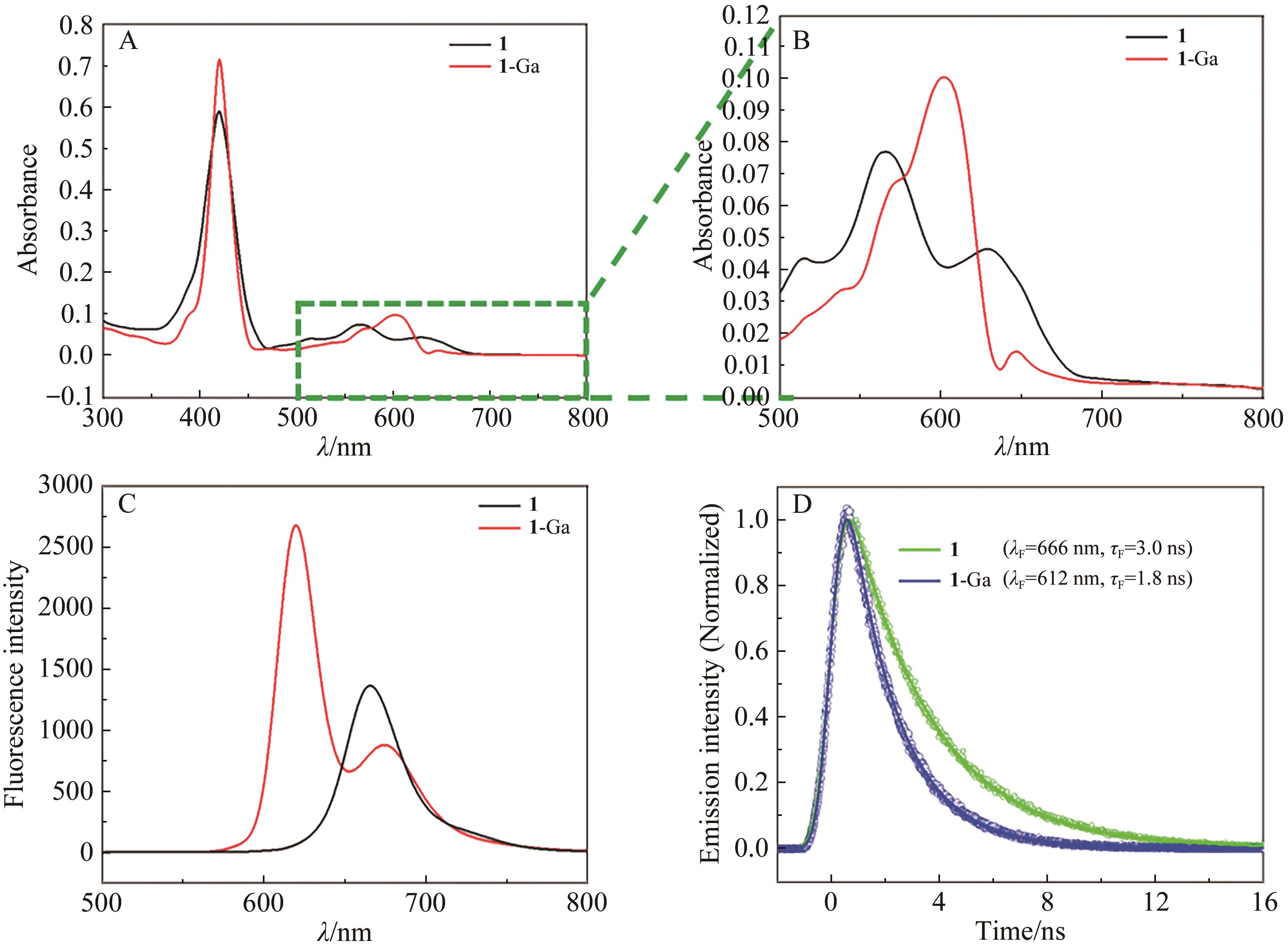
Fig.2 UV-Vis spectra of 1 and 1-Ga (A, B) ;FL spectra of 1 and 1-Ga (C) and the fluorescence attenuation profile of 1 and 1-Ga (D) at the peak wavelength of fluorescence (○, experimental curve; ---, fitting curve); The solvent is toluene, the test concentration is 5 μmol/L, and the excitation wavelength of fluorescence is 405 nm

Fig.3 Cytotoxic effects of 1 (A) and 1-Ga (B) on human hepatocel lular cancer cell lines with/without illumination. Optical images of MHCC97H cells after incubation with 1-Ga for 24 h in different concentration (C). Red arrows represent the apoptotic cells. The rulers are all 100 μm
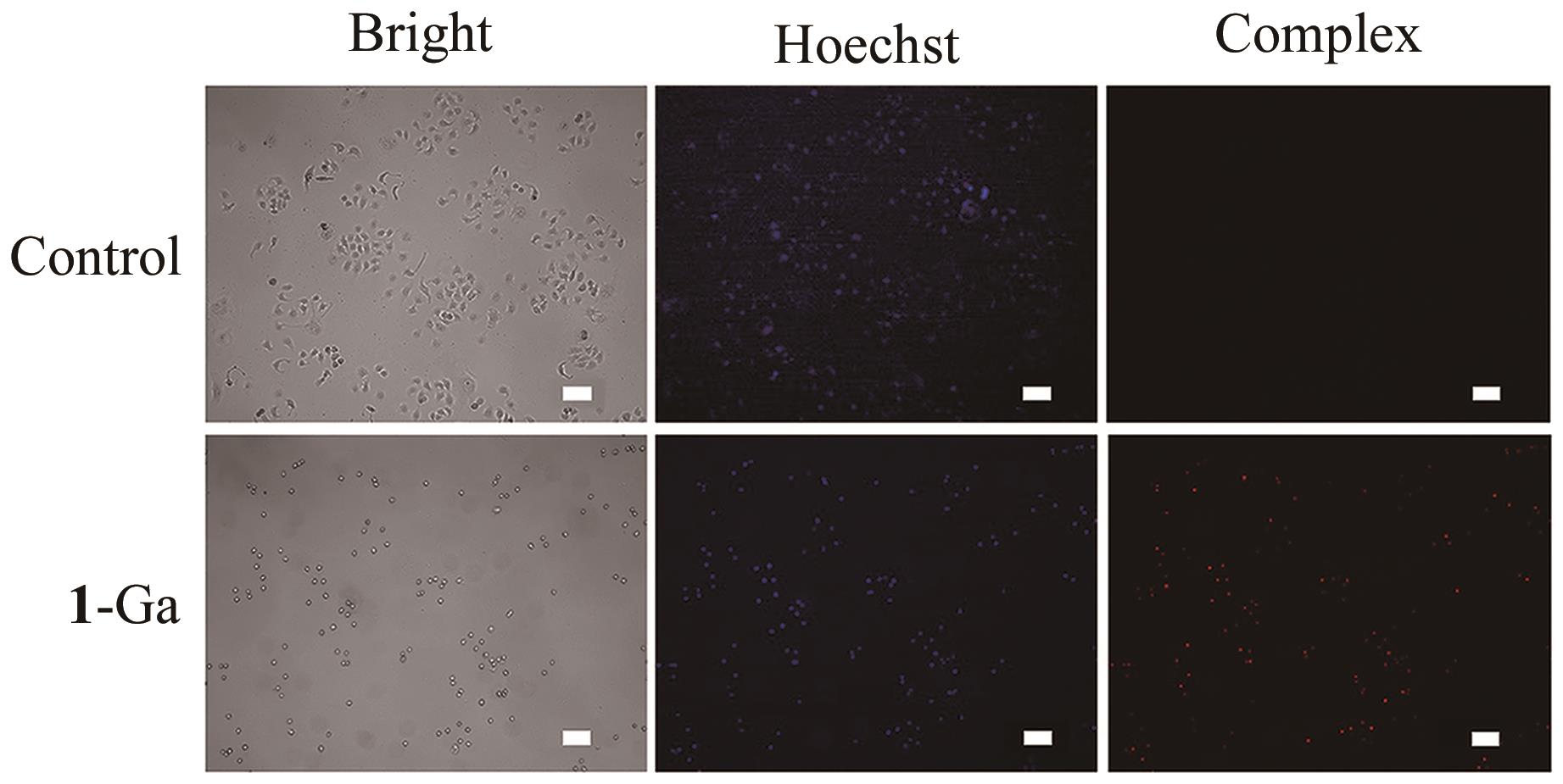
Fig.4 Cell localization of 1-Ga (2.0 μmol/L) in MHCC97H cells determined by fluorescence microscopy. Nuclei: Hoechst-33342 stain(blue). The rulers are all 100 μm. Complex represents the field of view of the red fluorescent channel
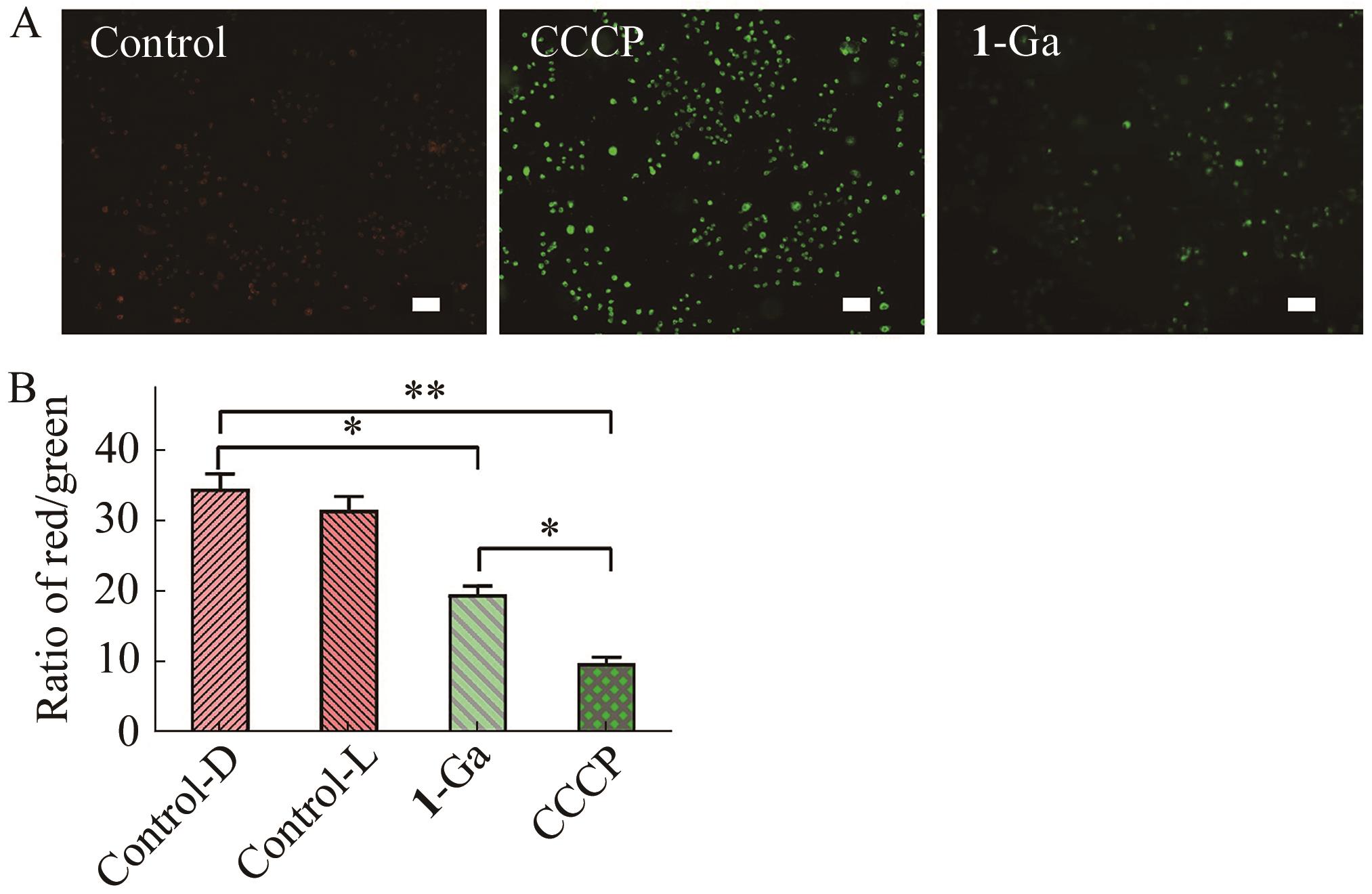
Fig.5 Effect of 1-Ga (2.0 μmol/L) on the MMP decrease in MHCC97H cells. MHCC97H cells were treated with 1-Ga for 24 h, and stained with the fluorescent probe JC-1. (Control) Representative images from three independent experiments are shown. (1-Ga) Quantitative analysis of the fluorescence intensity of JC-1 monomers or aggregates. **P<0.01, *P<0.05, n=3. The rulers are all 100 μm
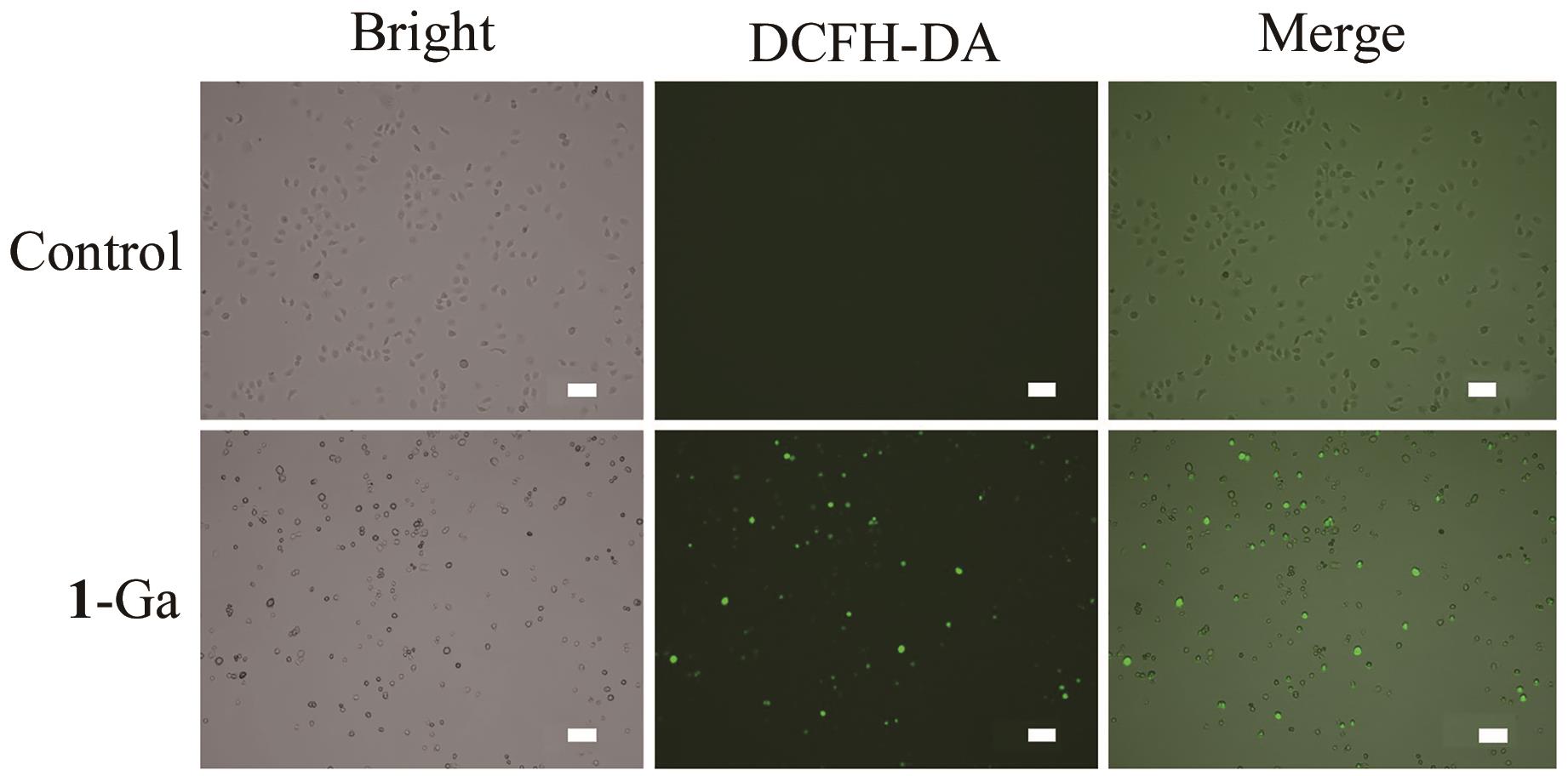
Fig.6 Intracellular ROS detection in MHCC97H cells after treatment with 1-Ga (2.0 μmol/L), which determined by fluorescence microscopy (The rulers are all 100 μm)
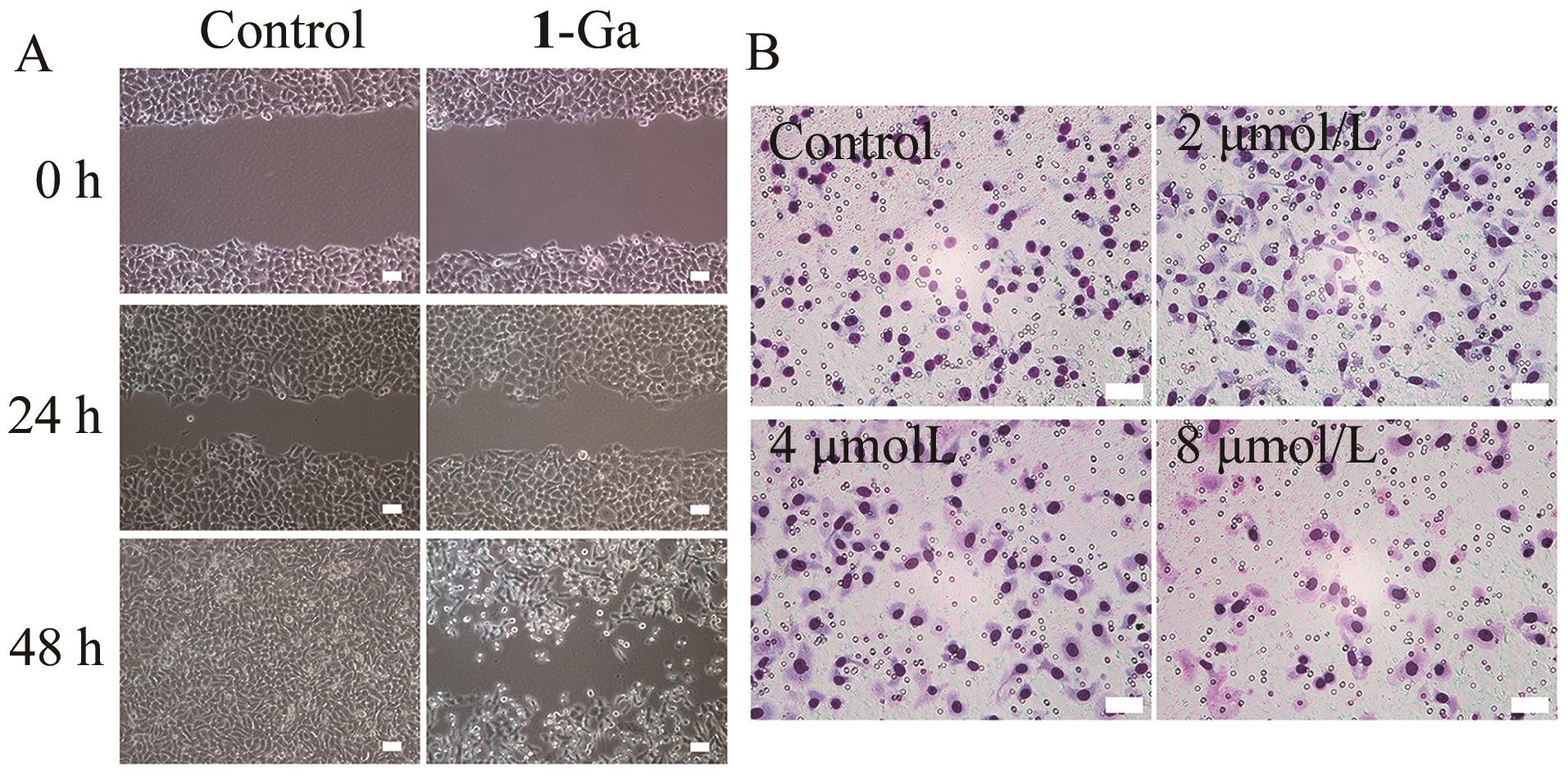
Fig.7 The study of cell motility and metastasis by wound healing assay and transwell assay. (A) A wound healing assay was used to evaluate the migration of MHCC97H after silencing by 1-Ga. (B) The effects of metastasis in MHCC97H cells after treatment with 1-Ga. The rulers are all 100 μm
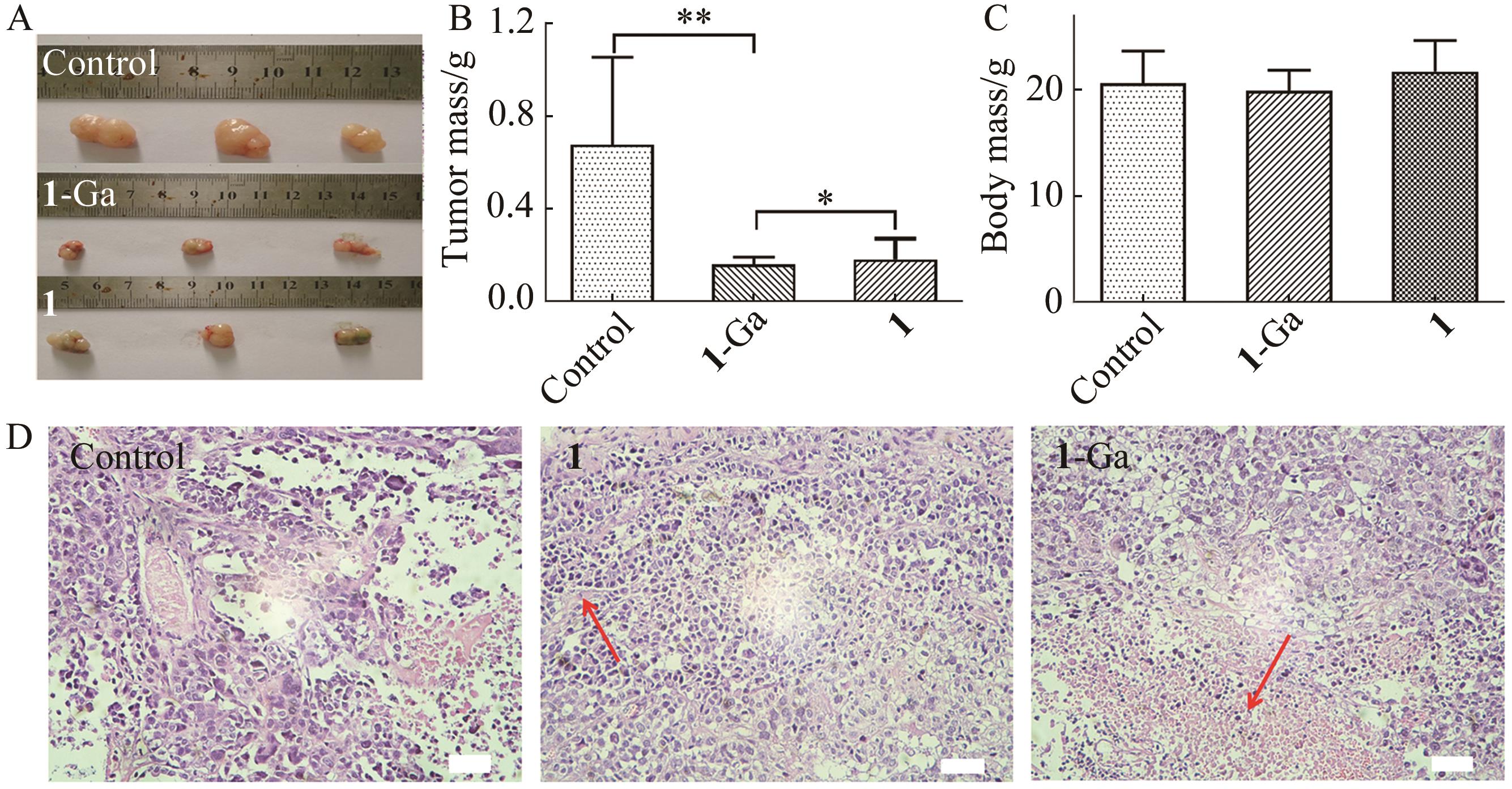
Fig.8 The photodynamic anti-tumor effect of 1-Ga in MHCC97H xenograft tumors. (A) Representative tumor images at 24 days post-PDT treatment. (B) The weight of the tumors for each group at the end of the observation period. (C) The body mass of mice from each group at the end of the observation period. Data are presented as the mean ± SEM. ** represents P<0.01, * represents P<0.05, n=3. (D) The histology analysis by H&E for the mice tumor after 1 and 1-Ga PDT treatment. Red arrows represent the apoptotic cells. The rulers are all 100 μm
| 1 | PAOLESSE R. Porphyrin handbook[M]. San Diego CA: Academic Press, CA, 2000: 201-232. |
| 2 | LIU H Y, LAI T S, YEUNG L L, et al. First synthesis of perfluorinated corrole and its Mn=O complex[J]. Org Lett, 2003, 5: 617-620. |
| 3 | FU B Q, HUANG J, REN L, et al. Cationic corrole derivatives: a new family of G-quadruplex inducing and stabilizing ligands[J]. Chem Commun, 2007, 31: 3264-3266. |
| 4 | MAHAMMED A, GROSS Z. Corroles as triplet photosensitizers[J]. Coord Chem Rev, 2019, 379: 121-132. |
| 5 | FU B Q, ZHANG D, WENG X C, et al. Cationic metal-corrole complexes: design, synthesis, and properties of guanine-quadruplex stabilizers[J]. Chem Eur J, 2008, 14: 9431-9441. |
| 6 | GROSS Z, MAHAMMED A, ABDALES M, et al. Bioinorganic chemistry of corrole metal complexes: interactions with proteins and cells[J]. J Inorg Biochem, 2003, 96: 140. |
| 7 | CHANG C K, KONG P W, LIU H Y, et al. Synthesis and photodynamic activities of modified corrole derivatives on nasopharyngeal carcinoma cells[J]. Proc SPIE, 2006, 6139: 613915. |
| 8 | SUN Y M, JIANG X, ZE Y L, et al. Hydroxy-corrole and its gallium(Ⅲ) complex as new photosensitizer for photodynamic therapy against breast carcinoma[J]. Eur J Med Chem, 2020, 112794 (208): 1-10. |
| 9 | WANG Y G, ZHANG Z, WANG H, et al. Phosphorus(Ⅴ) corrole: DNA binding, photonuclease activity and cytotoxicity toward tumor cells[J]. Bioorg Chem, 2016, 67: 57-63. |
| 10 | SHI L, YANG W C, ZENG S Y, et al. DNA-binding and anti-tumor activities of Cobalt corrole complexes[J]. Chin J Chem, 2016, 37: 1059-1068. |
| 11 | ZHANG Z, WANG H H, YU H J, et al. Synthesis, characterization and in vitro and in vivo photodynamic activities of a gallium(Ⅲ) tris(ethoxycarbonyl)corrole[J]. Dalton Trans, 2017, 29: 9481-9490. |
| 12 | ZHANG Z, WEN J Y, LV B B, et al. Photocytotoxicity and G-quadruplex DNA interaction of water-soluble gallium(Ⅲ) tris (N-methyl-4-pyridyl)corrole complex[J]. Appl Organomet Chem, 2016, 30: 132-139. |
| 13 | ZHANG Z, YU H J, HUANG H, et al. The photodynamic activity and toxicity evaluation of 5,10,15-tris(ethoxylcarbonyl)corrole phosphorus(V) in vivo and in vitro[J]. Eur J Med Chem, 2019, 163(1): 779-786. |
| 14 | ZHANG Z, YU H J, HUANG H, et al. The photocytotoxicity effect of cationic sulfonated corrole towards lung cancer cells: in vitro and in vivo study[J]. Laser Med Sci, 2019, 34(7): 1353-1363. |
| 15 | XI A N, ZHANG Z, WANG H H, et al. DNA-binding, photocleavage and anti-cancer activity of tin(Ⅳ) corrole[J]. J Porphyrin Phthalocya, 2018, 22: 739-750. |
| 16 | TEO R D, HWANG Y Y, TERMINI J, et al. Fighting cancer with corroles[J]. Chem Rev, 2017, 117: 2711-2729. |
| 17 | LI M Y, YANG W, CEN J H, et al. Gallium(Ⅲ) amide corroles: DNA interaction and photodynamic activity in cancer cells[J]. Chem Plus Chem, 2023, 88: e202200413. |
| 18 | LIU L G, SUN Y M, LIU Z Y, et al. Halogenated gallium corroles: DNA interaction and photodynamic antitumor activity[J]. Inorg Chem, 2021, 60: 2234-2245. |
| 19 | ZHANG Y, WEN J Y, WANG X L, et al. DNA binding and nuclease activity of cationic iron(Ⅳ) and manganese(Ⅲ) corrole complexes[J]. Appl Organomet Chem, 2014, 28: 559-566. |
| 20 | NA N, ZHAO D Q, LI H, et al. DNA binding, photonuclease activity and human serum albumin interaction of a water-soluble freebase carboxyl corrole[J]. Molecules, 2016, 21: 1-14. |
| 21 | ZHANG Y, WANG Q, WEN J Y, et al. DNA binding and oxidative cleavage by a water-soluble carboxyl manganese(Ⅲ) corrole[J]. Chin J Chem, 2013, 31: 1321-1328. |
| 22 | LU J, LIU H Y, SHI L, et al. DNA cleavage mediated by water-soluble manganese corrole[J]. Chin Chem Lett, 2011, 22: 101-104. |
| 23 | ZHANG Y, WEN J Y, MAHMOOD M H R, et al. DNA cleavage mediated by water-soluble manganese corrole[J]. Luminescence, 2015, 30: 1045-1054. |
| 24 | HUANG J T, WANG X L, ZHANG Y, et al. DNA binding and nuclease activity of a water-soluble sulfonated manganese(Ⅲ) corrole[J]. Transit Met Chem, 2013, 38: 283-289. |
| 25 | CHENG F, WANG H H, ATIF A L I, et al. Photophysical properties and photodynamic anti-tumor activity of corrole-coumarin dyads[J]. J Porphyrin Phthalocya, 2018, 22(9): 886-898. |
| 26 | WANG L L, WANG H, CHENG F, et al. Investigation of excited-state photophysical properties of water soluble gallium corrole[J]. J Phys Chem C, 2017, 121: 12350-12357. |
| 27 | RASU A, BAO R, MALHI M, et al. Induction of apoptosis by costunolide in bladder cancer cells is mediated through ROS generation and mitochondrial dysfunction[J]. Molecules, 2013, 18: 1418-1433. |
| 28 | KANKALA R K, LIU C G, CHEN A Z, et al. Overcoming multidrug resistance through the synergistic effects of hierarchical pH-sensitive, ROS-generating nanoreactors[J]. ACS Biomater Sci Eng, 2017, 3: 2431-2442. |
| [1] | Hong-Li YANG, Qian-Qi WANG, Huan WANG, Han YAN, Peng-Hui LIN, Jin-Qiu SONG, Yang DING, Shan-Hua LI, Fu-Nan LI. Structure Optimization, Synthesis and Anti-hepatocarcinoma Activity of Cinnamamide Compounds [J]. Chinese Journal of Applied Chemistry, 2023, 40(2): 261-267. |
| [2] | SHI Lei, YANG Wencong, SHEN Qi, YIN Wei, HUO Zhaohui, SI Liping, LIU Haiyang. Iron Corrole Complexes: DNA-Binding and Anti-tumor Activity [J]. Chinese Journal of Applied Chemistry, 2019, 36(12): 1376-1386. |
| [3] | SHENG Shihou1, YU Huiqiu1, LIU Tongjun1*, LIU Shi2, ZHENG Yonghui2, HU Xiuli2, SONG Xiangfu3. Anti-tumor Activity of Biodegradable Polymer-Paclitaxel Conjugate Micelles on H22 Liver Cancer Mice Models [J]. Chinese Journal of Applied Chemistry, 2011, 28(11): 1280-1285. |
| [4] | Liu Guihua, Yang Yonghui, Sun Sixiu, Li Xiaobin. The Extraction Kinetics of Ga(Ⅲ) with HDEHP [J]. Chinese Journal of Applied Chemistry, 1996, 0(6): 31-34. |
| [5] | Yu Xinwu, Wang Li, Zhang Jiyu, Zhang Shuyun, Wang Enbo, Yan Yu. Synthesis and Magnetizm of Na7H4[-GaW9O37Cu3(H2O)3]·18H2O [J]. Chinese Journal of Applied Chemistry, 1996, 0(3): 30-33. |
| [6] | Qian Daosun, Sun Lizbong, Shen Yi. A STUDY OF THE OUTPUT CHARACTERISTICS OF PHOTO ELECTROCHEMICAL CELL(PEC)BASED ON n-GaAs [J]. Chinese Journal of Applied Chemistry, 1988, 0(5): 93-95. |
| Viewed | ||||||
|
Full text |
|
|||||
|
Abstract |
|
|||||
